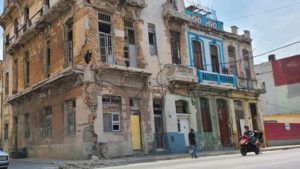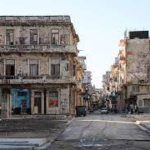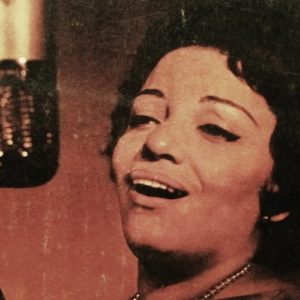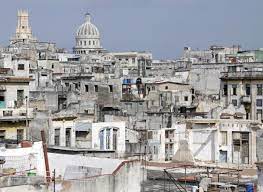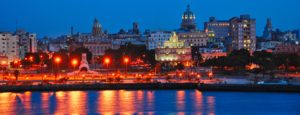CUBA POR DENTRO: LA HABANA, UNA CIUDAD “BOMBARDEADA” POR LA POBREZA Y EL ABANDONO. PHOTOS
San Lázaro y Perseverancia, otra esquina “bombardeada” de La Habana. En las aceras de una de las calles más derruidas de la capital, hay que evadir huecos, aguas albañales y desechos caídos de los balcones para cruzar.
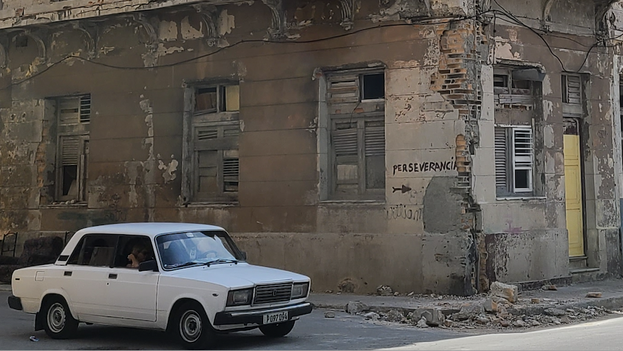
A falta de señales, la calle Perseverancia exhibe su nombre escrito a mano en una pared ruinosa. (14ymedio)
ÓSCAR DUERME “con un ojo abierto y otro cerrado” por si en medio de la madrugada el techo acaba por desplomarse sobre este habanero de 67 años y su familia. Residente en la esquina de Perseverancia y San Lázaro, en Centro Habana, el jubilado lleva años denunciando el mal estado de su edificio al que la falta de mantenimiento y el salitre han convertido en una ruina.
Sentado en la puerta de su apartamento, en planta baja, Óscar detalla la zozobra con la que vive entre los muros en el puro ladrillo, los balcones a los que ya se le han caído varios pedazos y las vigas expuestas y oxidadas. “Allá arriba en la azotea todavía queda una familia”, explica a 14ymedio y señala los pisos superiores sin puertas ni ventanas.
La situación de la familia de Óscar parece repetirse a donde quiera que se mire. La calle San Lázaro, una de las avenidas más importantes de la capital cubana, es también una de las vías con mayor deterioro. Aunque el daño se extiende desde su nacimiento próximo al Malecón hasta su final ante la escalinata de la Universidad de La Habana, es el tramo desde el Paseo del Prado hasta Belascoaín el más afectado.
En ese pedazo, San Lázaro ha perdido casi medio centenar de edificios total o parcialmente. La cercanía del mar, la desidia estatal y los pocos recursos de los residentes en esa zona han dejado a la avenida como si hubiera sido bombardeada. Los huecos en sus fachadas, las cornisas hechas pedazos y los balcones derruidos parecen sacados de una ciudad en plena guerra.
En las entrecalles se repite el panorama. Perseverancia, sin la extensión de su vecina Lealtad ni la importancia de la cercana Galiano, es una de las vías más derruidas. Donde antes había una carnicería ahora solo queda una puerta tapiada y el hueco de una ventana por donde los vecinos lanzan bolsas de basura. En las aceras hay que evadir huecos, aguas albañales y desechos caídos de los balcones.
LA HABANA SE CAE A PEDAZOS
“Hay que ir caminando por la calle porque si que te arrolle un carro es peligroso, peor es que te caiga un pedazo de edificio en la cabeza”, rezonga una joven que ha salido de una cuartería. Al llegar a la esquina la mujer debe sortear una montaña de desechos acumulada durante semanas “en que no ha pasado el camión de la basura”. Cuando se acerca, decenas de moscas levantan el vuelo y unos segundos después se vuelven a posar sobre las bolsas con residuos.
Un hombre empuja una carretilla con frutas y vegetales que va dando saltos cada vez que una de las ruedas cae en un hueco. El vendedor se va alejando del mar y al llegar frente al número 156, una mujer le pregunta por el precio de los limones. La señora está asomada a la ventana de una casona completamente restaurada que hace las veces de hostal para turistas. “El encanto de perseverancia” con su fachada pintada de amarillo, sus puertas elegantes y sus rejas impecables parece una nave espacial reluciente que ha aterrizado en medio de la mugre y los derrumbes.
Construida a inicios del siglo XX y remodelada en 2013, la casona tiene un amplio patio central, lámparas antiguas colgando de sus altos techos, varias habitaciones de renta y una suite de 40 metros cuadrados que en temporada alta puede costar hasta más de 100 dólares por noche. En la azotea, los clientes disfrutan de la vista del mar y se alejan del paisaje desolado de la calle que discurre abajo.
Justo frente de la casona turística, en el número 159, siete personas, incluyendo dos niños, murieron en junio pasado al quedar atrapados en el interior de una vivienda donde una moto eléctrica se incendió. La tragedia ha dejado una honda herida entre los vecinos y ha añadido más ruina a la calle Perseverancia, donde las únicas cosas que parecen perseverar por todos lados son la destrucción y la desesperanza.
INSIDE CUBA: HAVANA, A CITY THAT SEEMS “BOMBARDED” BY POVERTY AND ABANDONMENT. PHOTOS.
San Lázaro and Perseverancia, another “bombarded” corner of Havana. On the sidewalks of one of the most dilapidated streets in the capital, you have to avoid holes, sewage and debris fallen from the balconies to cross.
ÓSCAR SLEEPS “with one eye open and the other closed” in case in the middle of the morning the roof ends up collapsing on this 67-year-old Havana man and his family. Resident at the corner of Perseverancia and San Lázaro, in Centro Habana, the retiree has spent years denouncing the poor condition of his building, which the lack of maintenance and saltpeter have turned into a ruin.
Sitting at the door of his apartment, on the ground floor, Óscar details the anxiety with which he lives between the pure brick walls, the balconies that have already fallen several pieces and the exposed and rusty beams. “Up there on the roof there is still a family,” he explained to 14ymedio, pointing to the upper floors without doors or windows.
The situation of Óscar’s family seems to be repeated everywhere he wants to look. San Lázaro street, one of the most important avenues in the Cuban capital, is also one of the streets with the greatest deterioration. Although the damage extends from its source near the Malecón to its end in front of the steps of the University of Havana, the section from Paseo del Prado to Belascoaín is the most affected.
In that piece, San Lázaro has lost almost fifty buildings totally or partially. The proximity of the sea, the neglect of the state and the few resources of the residents in that area have left the avenue as if it had been bombed. The holes in its facades, the shattered cornices and the collapsed balconies seem to have been taken from a city in the midst of war.
In the streets the panorama is repeated. Perseverancia, without the extension of its neighbor Lealtad or the importance of nearby Galiano, is one of the most dilapidated routes. Where before there was a butcher shop, now there is only a bricked-up door and a window hole through which the neighbors throw garbage bags. On the sidewalks you have to avoid holes, sewage and debris fallen from the balconies.
HAVANA FALLS TO PIECES
“You have to walk down the street because if you get hit by a car it’s dangerous, it’s worse if a piece of a building falls on your head,” grumbles a young woman who has left a cuartería. Upon reaching the corner, the woman must navigate a mountain of rubbish accumulated for weeks “in which the garbage truck has not passed.” When she approaches, dozens of flies take flight and a few seconds later they return to settle on the bags with waste.
A man pushes a wheelbarrow with fruits and vegetables that bounces every time one of the wheels falls into a hole. The vendor moves away from the sea and when he arrives in front of number 156, a woman asks him for the price of the lemons. The lady is leaning out of the window of a completely restored house that serves as a hostel for tourists. “The Charm of Perseverance” with its yellow-painted facade, elegant doors and spotless railings looks like a shiny spaceship that has landed in the midst of grime and cave-ins.
Built at the beginning of the 20th century and remodeled in 2013, the house has a large central patio, antique lamps hanging from its high ceilings, several rooms for rent, and a 40-square-meter suite that can cost more than $100 per room in high season. evening. On the rooftop, patrons enjoy the view of the sea and get away from the desolate landscape of the street below.
Right in front of the tourist house, at number 159, seven people, including two children, died last June when they were trapped inside a house where an electric motorcycle caught fire. The tragedy has left a deep wound among the neighbors and added more ruin to Perseverancia Street, where the only things that seem to persevere everywhere are destruction and hopelessness.
Agencies/ Wiki/ 14yMedio/ Nelson Garcia/ La Habana/ Extractos/ Excerpts/ Internet Photos/ Arnoldo Varona/ www.TheCubanHistory.com
THE CUBAN HISTORY, HOLLYWOOD.



